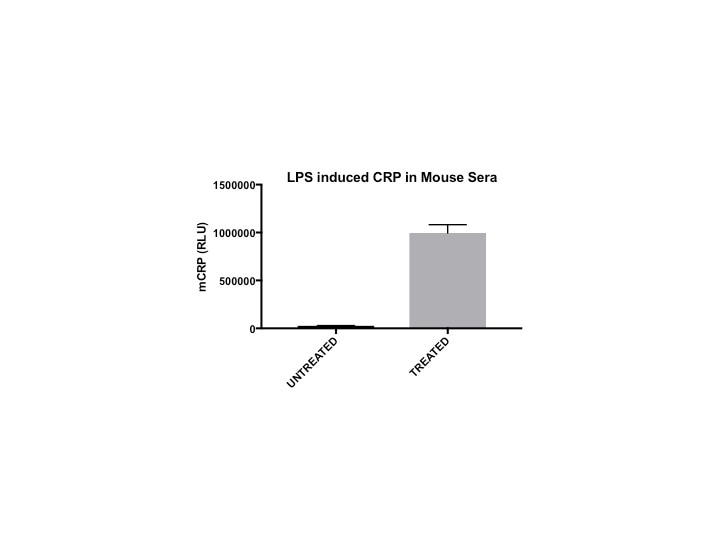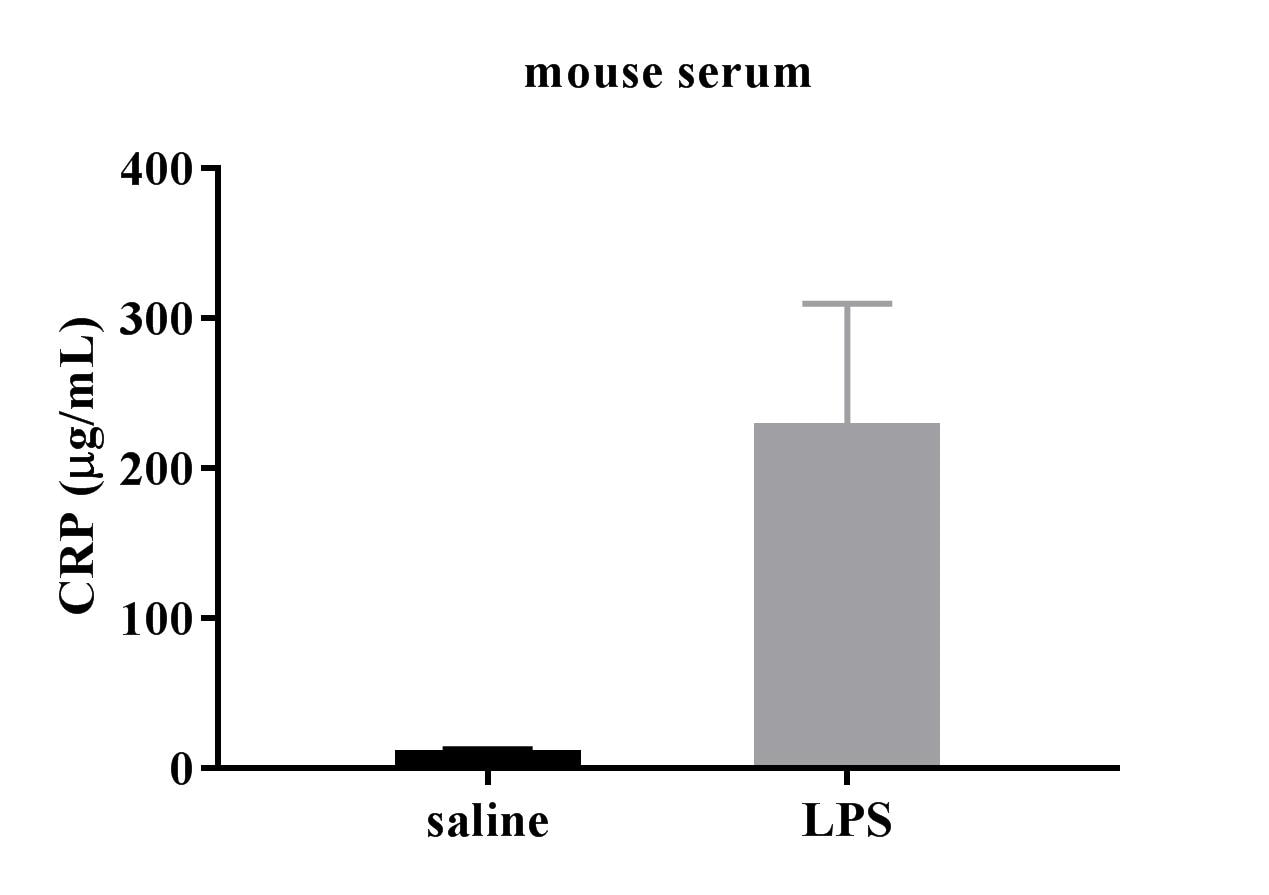Mouse C-Reactive Protein/CRP DuoSet ELISA
Mouse C-Reactive Protein/CRP DuoSet ELISA Summary
* Provided that the recommended microplates, buffers, diluents, substrates and solutions are used, and the assay is run as summarized in the Assay Procedure provided.
This DuoSet ELISA Development kit contains the basic components required for the development of sandwich ELISAs to measure natural and recombinant mouse C-Reactive Protein/CRP. The suggested diluent is suitable for the analysis of most cell culture supernate samples. Diluents for complex matrices, such as serum and plasma, should be evaluated prior to use in this DuoSet.
Product Features
- Optimized capture and detection antibody pairings with recommended concentrations save lengthy development time
- Development protocols are provided to guide further assay optimization
- Assay can be customized to your specific needs
- Economical alternative to complete kits
Kit Content
- Capture Antibody
- Detection Antibody
- Recombinant Standard
- Streptavidin conjugated to horseradish-peroxidase (Streptavidin-HRP)
Other Reagents Required
DuoSet Ancillary Reagent Kit 2 (5 plates): (Catalog # DY008) containing 96 well microplates, plate sealers, substrate solution, stop solution, plate coating buffer (PBS), wash buffer, and Reagent Diluent Concentrate 2.
The components listed above may be purchased separately:
PBS: (Catalog # DY006), or 137 mM NaCl, 2.7 mM KCl, 8.1 mM Na2HPO4, 1.5 mM KH2PO4, pH 7.2 - 7.4, 0.2 µm filtered
Wash Buffer: (Catalog # WA126), or 0.05% Tween® 20 in PBS, pH 7.2-7.4
Reagent Diluent: (Catalog # DY995), or 1% BSA in PBS, pH 7.2-7.4, 0.2 µm filtered
Substrate Solution: 1:1 mixture of Color Reagent A (H2O2) and Color Reagent B (Tetramethylbenzidine) (Catalog # DY999)
Stop Solution: 2 N H2SO4 (Catalog # DY994)
Microplates: R&D Systems (Catalog # DY990)
Plate Sealers: ELISA Plate Sealers (Catalog # DY992)
Scientific Data
Product Datasheets
Preparation and Storage
Background: C-Reactive Protein/CRP
C-Reactive Protein (CRP), also known as Pentraxin 1, is a secreted pentameric protein that functions as a sensor and activator for the innate immune response. In humans, it is a major acute-phase protein; its circulating concentration is dramatically elevated at the onset of inflammation. In mice, however, serum CRP levels increase only slightly during inflammation, and the analogous acute phase role is filled by Pentraxin 2. CRP binds, opsonizes, and induces the phagocytosis of bacteria and apoptotic cells. It regulates activation of the classical complement pathway by binding several proteins in the complement cascade as well as Fc gamma RI, Fc gamma RIIA, and Fc gamma RIIB on macrophages and dendritic cells. It also promotes dendritic cell maturation and humoral immunity. In cardiovascular disease, CRP binds to oxidized LDL, exacerbates tissue damage in myocardial infarction, and inhibits the repair of injured vascular endothelium.
Assay Procedure
GENERAL ELISA PROTOCOL
Plate Preparation
- Dilute the Capture Antibody to the working concentration in PBS without carrier protein. Immediately coat a 96-well microplate with 100 μL per well of the diluted Capture Antibody. Seal the plate and incubate overnight at room temperature.
- Aspirate each well and wash with Wash Buffer, repeating the process two times for a total of three washes. Wash by filling each well with Wash Buffer (400 μL) using a squirt bottle, manifold dispenser, or autowasher. Complete removal of liquid at each step is essential for good performance. After the last wash, remove any remaining Wash Buffer by aspirating or by inverting the plate and blotting it against clean paper towels.
- Block plates by adding 300 μL Reagent Diluent to each well. Incubate at room temperature for a minimum of 1 hour.
- Repeat the aspiration/wash as in step 2. The plates are now ready for sample addition.
Assay Procedure
- Add 100 μL of sample or standards in Reagent Diluent, or an appropriate diluent, per well. Cover with an adhesive strip and incubate 2 hours at room temperature.
- Repeat the aspiration/wash as in step 2 of Plate Preparation.
- Add 100 μL of the Detection Antibody, diluted in Reagent Diluent, to each well. Cover with a new adhesive strip and incubate 2 hours at room temperature.
- Repeat the aspiration/wash as in step 2 of Plate Preparation.
- Add 100 μL of the working dilution of Streptavidin-HRP to each well. Cover the plate and incubate for 20 minutes at room temperature. Avoid placing the plate in direct light.
- Repeat the aspiration/wash as in step 2.
- Add 100 μL of Substrate Solution to each well. Incubate for 20 minutes at room temperature. Avoid placing the plate in direct light.
- Add 50 μL of Stop Solution to each well. Gently tap the plate to ensure thorough mixing.
- Determine the optical density of each well immediately, using a microplate reader set to 450 nm. If wavelength correction is available, set to 540 nm or 570 nm. If wavelength correction is not available, subtract readings at 540 nm or 570 nm from the readings at 450 nm. This subtraction will correct for optical imperfections in the plate. Readings made directly at 450 nm without correction may be higher and less accurate.
Citations for Mouse C-Reactive Protein/CRP DuoSet ELISA
R&D Systems personnel manually curate a database that contains references using R&D Systems products. The data collected includes not only links to publications in PubMed, but also provides information about sample types, species, and experimental conditions.
7
Citations: Showing 1 - 7
Filter your results:
Filter by:
-
Efficacy of a Probiotic and Herbal Supplement in Models of Lung Inflammation
Authors: NM Wenger, L Qiao, T Nicola, Z Nizami, X Xu, KA Willis, N Ambalavana, A Gaggar, CV Lal
Microorganisms, 2022-10-28;10(11):.
Species: Mouse
Sample Types: Serum
-
Gene-diet interactions associated with complex trait variation in an advanced intercross outbred mouse line
Authors: A Vorobyev, Y Gupta, T Sezin, H Koga, YC Bartsch, M Belheouane, S Künzel, C Sina, P Schilf, H Körber-Ahr, F Beltsiou, A Lara Ernst, S Khil'chenk, H Al-Aasam, RA Manz, S Diehl, M Steinhaus, J Jascholt, P Kouki, WH Boehncke, TN Mayadas, D Zillikens, CD Sadik, H Nishi, M Ehlers, S Möller, K Bieber, JF Baines, SM Ibrahim, RJ Ludwig
Nat Commun, 2019-09-10;10(1):4097.
Species: Mouse
Sample Types: Serum
-
Myocardial Ischemia Reperfusion Injury: Apoptotic, Inflammatory and Oxidative Stress Role of Galectin-3
Authors: S Al-Salam, S Hashmi
Cell. Physiol. Biochem., 2018-10-24;50(3):1123-1139.
Species: Mouse
Sample Types: Tissue Homogenates
-
Pretreatment of Low-Dose and Super-Low-Dose LPS on the Production of In Vitro LPS-Induced Inflammatory Mediators
Authors: BS Chae
Toxicol Res, 2018-01-15;34(1):65-73.
Species: Mouse
Sample Types: Cell Culture Supernates
-
Early anti-inflammatory intervention ameliorates axial disease in the proteoglycan-induced spondylitis mouse model of ankylosing spondylitis
Authors: HW Tseng, TT Glant, MA Brown, TJ Kenna, GP Thomas, AR Pettit
BMC Musculoskelet Disord, 2017-05-30;18(1):228.
Species: Mouse
Sample Types: Serum
-
Metalloproteinase-9 contributes to endothelial dysfunction in atherosclerosis via protease activated receptor-1
Authors: JM Florence, A Krupa, LM Booshehri, TC Allen, AK Kurdowska
PLoS ONE, 2017-02-06;12(2):e0171427.
Species: Mouse
Sample Types: Plasma
-
Altered regulation of Toll-like receptor responses impairs antibacterial immunity in the allergic lung.
Authors: Habibzay, M, Saldana, J I, Goulding, J, Lloyd, C M, Hussell, T
Mucosal Immunol, 2012-05-02;5(5):524-34.
Species: Mouse
Sample Types: BALF
FAQs
No product specific FAQs exist for this product, however you may
View all ELISA FAQsReviews for Mouse C-Reactive Protein/CRP DuoSet ELISA
Average Rating: 5 (Based on 2 Reviews)
Have you used Mouse C-Reactive Protein/CRP DuoSet ELISA?
Submit a review and receive an Amazon gift card.
$25/€18/£15/$25CAN/¥75 Yuan/¥2500 Yen for a review with an image
$10/€7/£6/$10 CAD/¥70 Yuan/¥1110 Yen for a review without an image
Filter by:



